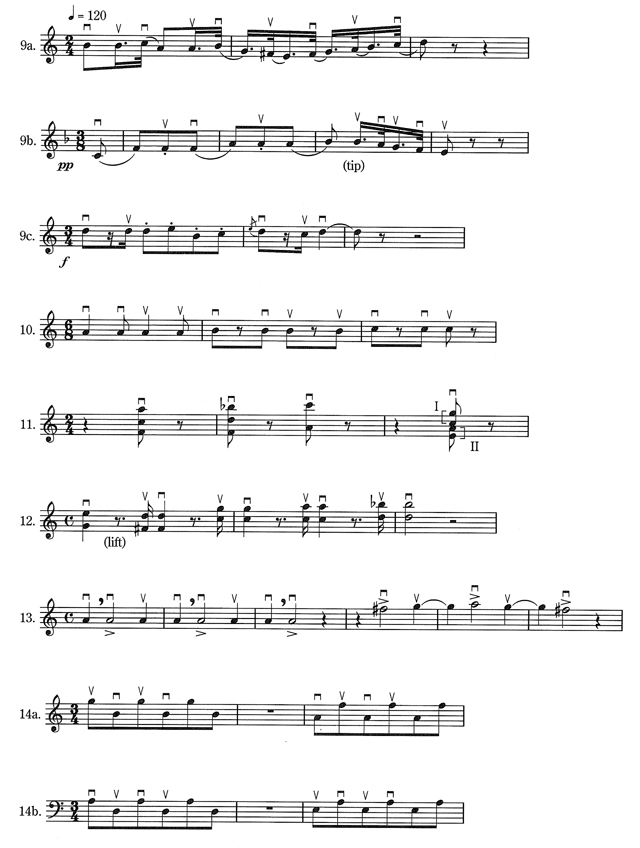Bowings
Slurs
Slurs are lines extending over note groupings to indicate that they are to be played under a single bow direction. These are identical to phrase markings, but short slurred groupings are interpreted as bow direction. The downbow or upbow symbol is placed over the beginning of the slur. 
The tempo, dynamic levels, and character of the music dictate the types of bowing possible.
Bowing Styles
On the String
In all these bowing styles, the bow stays in constant contact with the string:
- Legato: Slurred, as smooth as possible.
- Detache: Each note bowed in a separate direction; may be accented or smooth; no bow markings indicated.
- Martele (hammered): A misleading term referring to “on the string” staccato; start fast, end abruptly, separate the tones.
- Loure (portato): Two or more notes taken on one bow, brush strokes, pushed with slight separations.

FIGURE 2.6 Example of loure bowing
5. Slurred staccato: Hooked bowing; similar to loure with shorter note values.

Off the String
Fast passages played staccato will usually be played off the string. In all of these bowing styles, the bow leaves the string:
- Spiccato: Midbow bounce, indicated by dots over notes, with no slurs
- Repeated bows: Consecutive downbow or upbow
- Ricochet or jete: Throwing the bow on the string, allowing it to bounce

FIGURE 2.8 Staccato volante (upbow spiccato) and saltando (downbow spiccato)
Fourteen Basic Principles of Bow Direction
- The note on the first beat of the measure is usually a downbow.
- The unslurred note before the bar line (last note in a bar) is an upbow.
- If the note before the bar line (upbeat) is slurred across the bar line, play it downbow.
- An odd number of notes before a bar line (unslurred and after a rest or silence) starts an upbow.
- An even number of notes before a bar line (unslurred and after a rest or silence) starts a downbow.
- Alternate the bows (down, up) on afterbeats. If rhythmic figures between beats have an even number of notes, try a downbow on the first note; if they have an odd number of notes, try an upbow on the first note. The note with the greatest accent is played downbow.
- If groups of four even unslurred notes occur, starting on the beat, play the first one downbow.
- Link (hook) the dotted eighth and sixteenth.
- Do not link the dotted eighth and sixteenth in the following situations:
- The tempo is too fast to permit articulation.
- The soft passage requires extreme clarity of sound.
- A loud, choppy effect is desired.
- Link the quarter and eighth in 6/8 time.
- Multiple stops are usually played downbow, two voices each chair.
- If the closing chord or note has a short note before it, play the short note upbow near the frog.
- In 4/4 time an accented half note on the second beat of the measure is taken downbow.
- In continuous string crossing (unslurred) take the upper note upbow on violin and viola and downbow on cello and contrabass.

